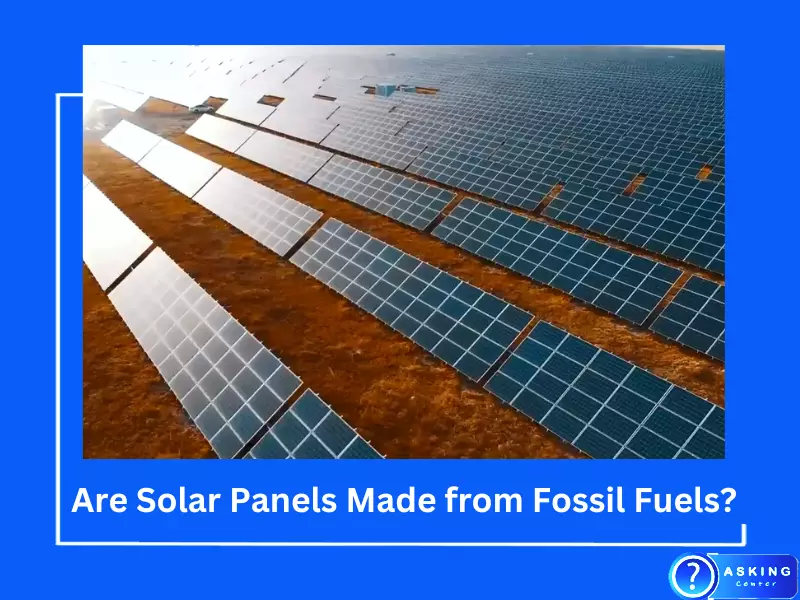Solar energy is the way of the future. As the world moves towards sustainable energy sources, solar panels are becoming more prevalent, providing clean, renewable power to millions of homes worldwide. However, it might surprise you to learn that the manufacturing of these shiny panels isn’t completely free from the influence of fossil fuels.
Yes, you read that right. The production of solar panels involves the utilization of fossil fuels, including coal, to a certain extent. This seemingly paradoxical reality reveals the complex nature of our energy production systems and the challenges we face in our pursuit of sustainability.
Undeniably, this information may seem somewhat discouraging, particularly if you’re passionate about green energy solutions. But don’t turn away just yet. This article will provide a thorough analysis of the intricate relationship between solar panels and fossil fuels, from the manufacturing process to their environmental implications.
Composition of Solar Panels
Basic Components of a Solar Panel
Solar panels are intricate devices designed to convert the sun’s rays into usable electricity. This process involves several key components. The main part of the solar panel is the photovoltaic (PV) cell, often made from silicon. This element is responsible for capturing sunlight and turning it into electricity.

Importance of Solar Energy Conversion Components
These PV cells are vital to the process of converting solar energy into electricity. The silicon cells absorb photons from sunlight, exciting electrons and setting them into motion, which creates an electrical current. This current, known as a direct current (DC), is then transformed into an alternating current (AC) by an inverter, making it usable in most homes and businesses.
Role of Coal in Solar Panel Manufacturing
Is Coal Used to Make Solar Panels?
Coal’s primary role in solar panel production is indirect. It provides the energy needed for the production of solar-grade silicon and the assembly of the solar panels themselves. Coal isn’t directly incorporated into the solar panel; however, its use in the manufacturing process does contribute to the panels’ overall carbon footprint.
How Much Coal Does It Take to Make a Solar Panel?
It’s challenging to quantify precisely how much coal is used to create a single solar panel, as it heavily depends on the efficiency of the manufacturing process, which can vary significantly. However, it is estimated that the manufacturing of solar panels consumes around 75% of the energy that they will produce in their lifetime, most of which is often sourced from fossil fuels like coal.
Other Fossil Fuels in Solar Panel Manufacturing
Besides coal, other fossil fuels such as natural gas and oil play a significant role in the solar panel manufacturing process. These resources are often used to generate the electricity needed for silicon refinement and the assembly of the panels.
Again, the exact amounts of natural gas and oil used in solar panel production can vary widely. But just like coal, these fossil fuels contribute to the carbon emissions and overall environmental impact of solar panel manufacturing.
Environmental Impact of Solar Panel Manufacturing
Carbon Footprint
Despite being a source of clean energy, the production of solar panels does leave a carbon footprint. This is largely due to the fossil fuels used during the manufacturing process, contributing to greenhouse gas emissions.
Pollution
Additionally, the solar panel production process can generate certain types of pollution. This includes chemical waste from the refinement of silicon and other materials, and air pollution resulting from the combustion of fossil fuels.

Comparing Solar Panels and Traditional Energy Sources
While the manufacturing of solar panels does involve the use of fossil fuels and creates some environmental impact, it’s important to put this in perspective.
Traditional energy sources such as coal and gas power plants have a far greater environmental impact, both in terms of carbon emissions and other pollutants. Furthermore, once installed, solar panels generate clean, renewable energy for many years, offsetting the initial environmental cost of their production.
Current Technological Advances and Their Impacts
New Techniques to Reduce Fossil Fuel Use
Advancements in technology are continually reducing the amount of fossil fuel needed in solar panel production. For instance, energy-efficient manufacturing techniques are now being developed that reduce the amount of electricity needed to produce solar-grade silicon.
Decreasing Environmental Impact
These advancements not only lessen the dependence on fossil fuels but also reduce the overall environmental impact of solar panel production. They decrease both the carbon footprint of each panel and the amount of pollution generated during their manufacturing process. This progress aligns with the overall goal of solar energy: to provide a sustainable, environmentally friendly energy solution.
Frequently Asked Questions
Do solar panels make up for their carbon footprint?
Yes, while solar panels do have a carbon footprint due to the fossil fuels used in their manufacturing, they typically make up for it within a few years of operation. After this period, the clean, renewable energy they produce significantly offsets the initial emissions from their production.
Can solar panels be recycled?
Yes, solar panels can be recycled. Many parts of a solar panel, including the glass, aluminum, and certain types of silicon, can be recovered and reused. However, the recycling process is complex and not yet widely available, though efforts are being made to improve this.
Are there alternatives to using fossil fuels in solar panel production?
While fossil fuels are currently used in the manufacturing of solar panels, research is ongoing into more sustainable methods. This includes more energy-efficient manufacturing processes and the use of alternative, renewable energy sources to power the manufacturing process.
Conclusion
The relationship between solar panels and fossil fuels is complex. While it’s true that fossil fuels are used in the manufacturing of solar panels, it’s essential to consider the broader picture. Solar panels provide a source of clean, renewable energy for many years after their production, offsetting their initial environmental impact.
Furthermore, ongoing advancements in technology promise to reduce this impact further, moving us closer to a truly sustainable energy future.

